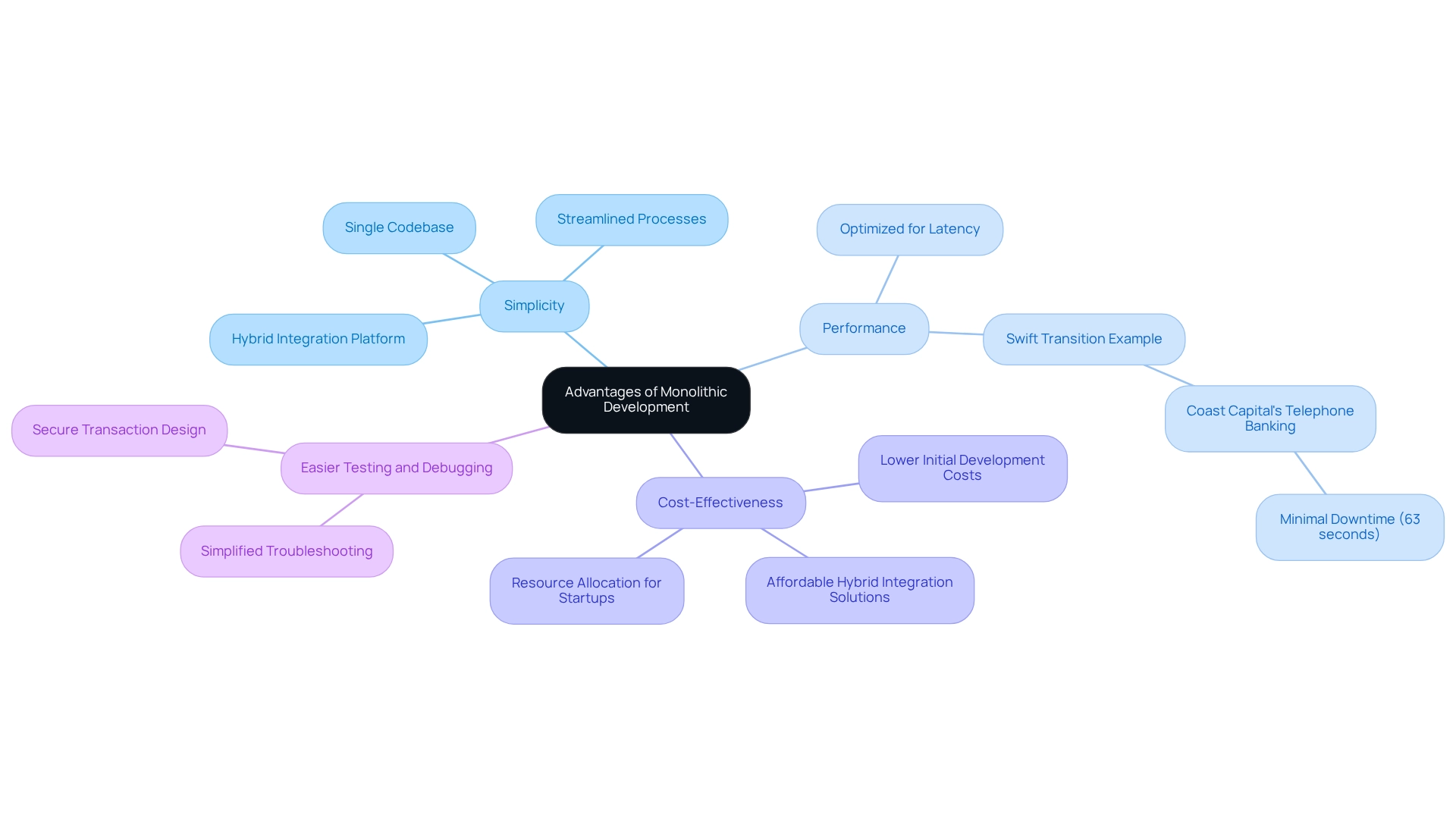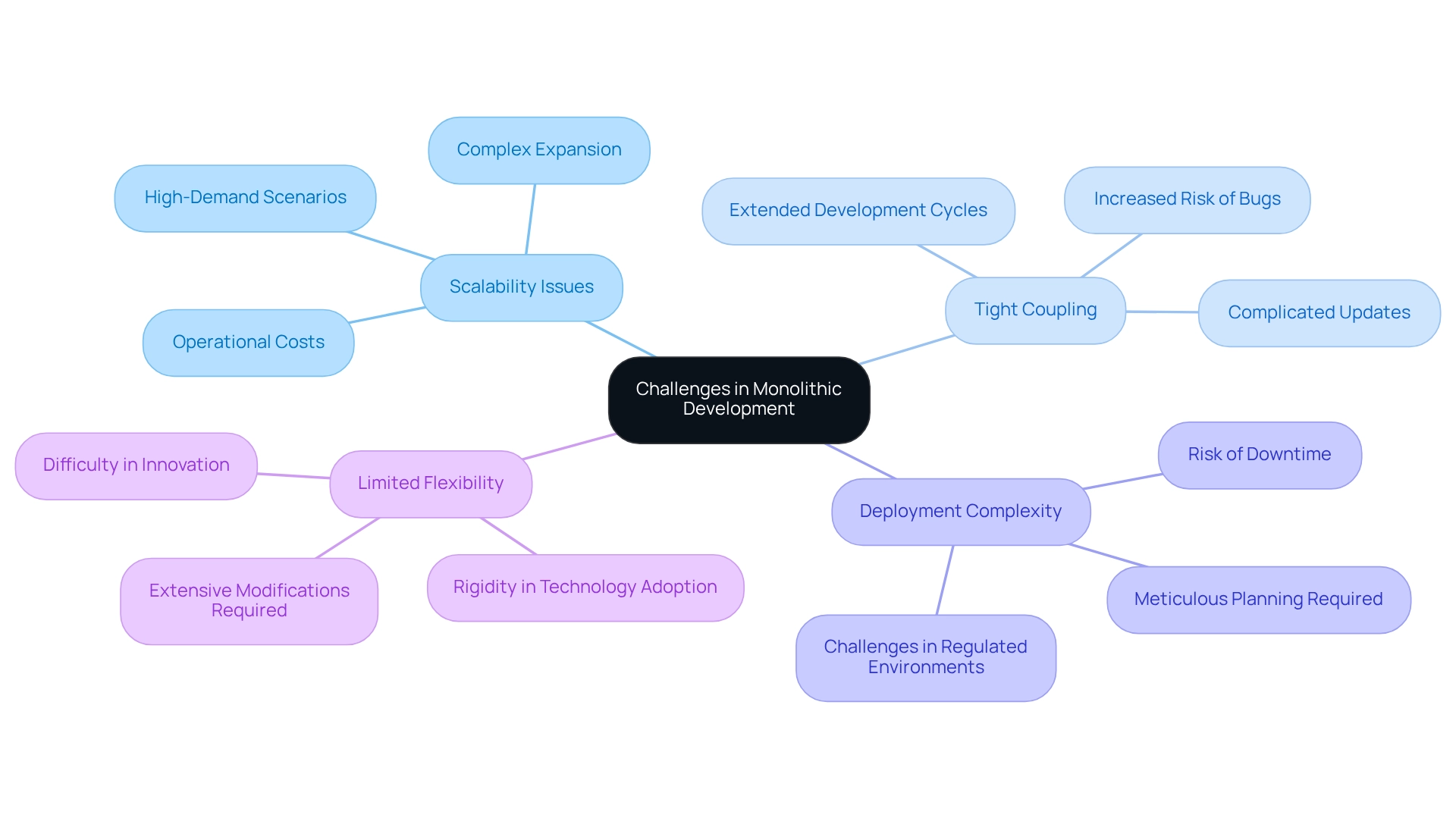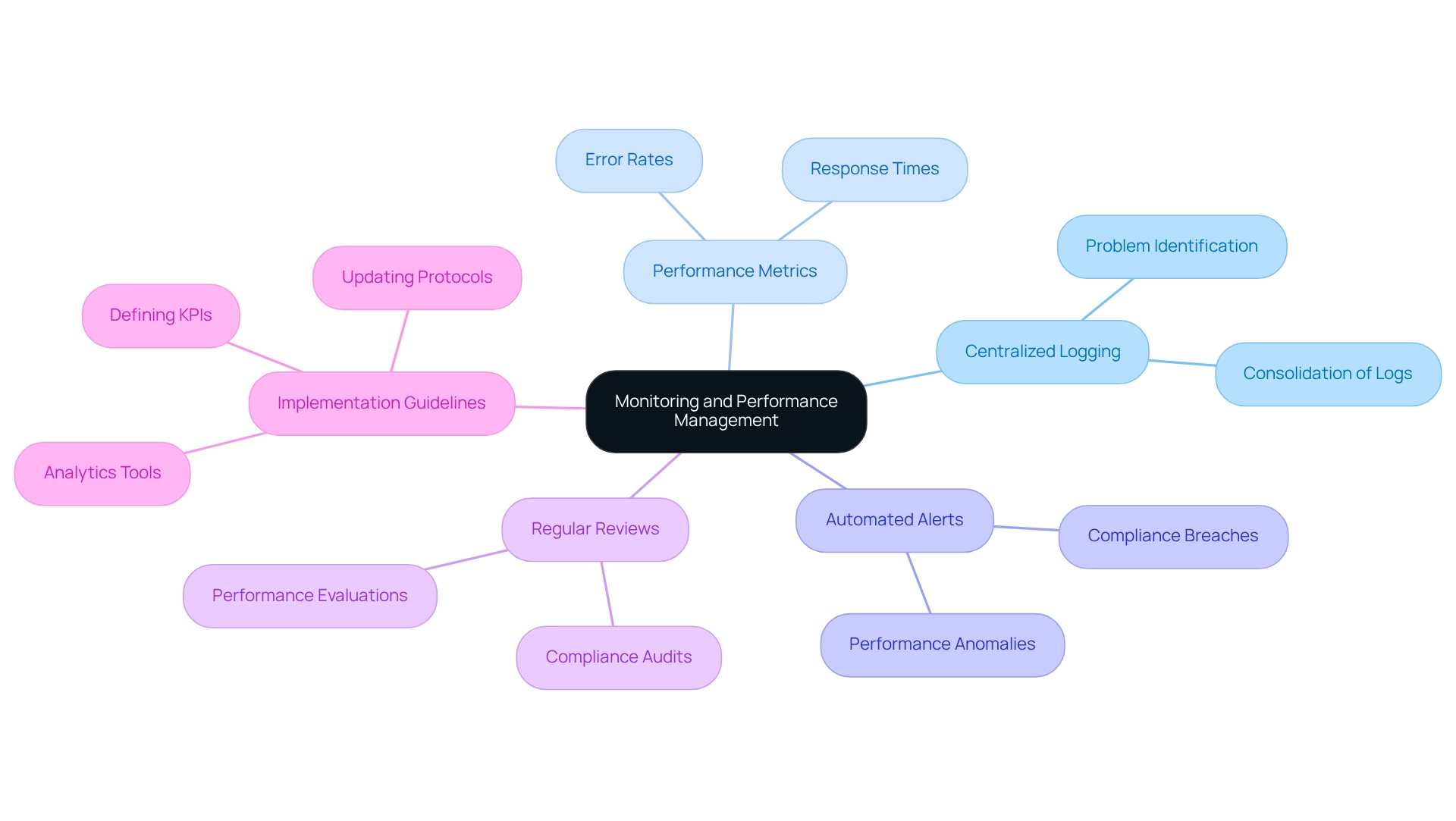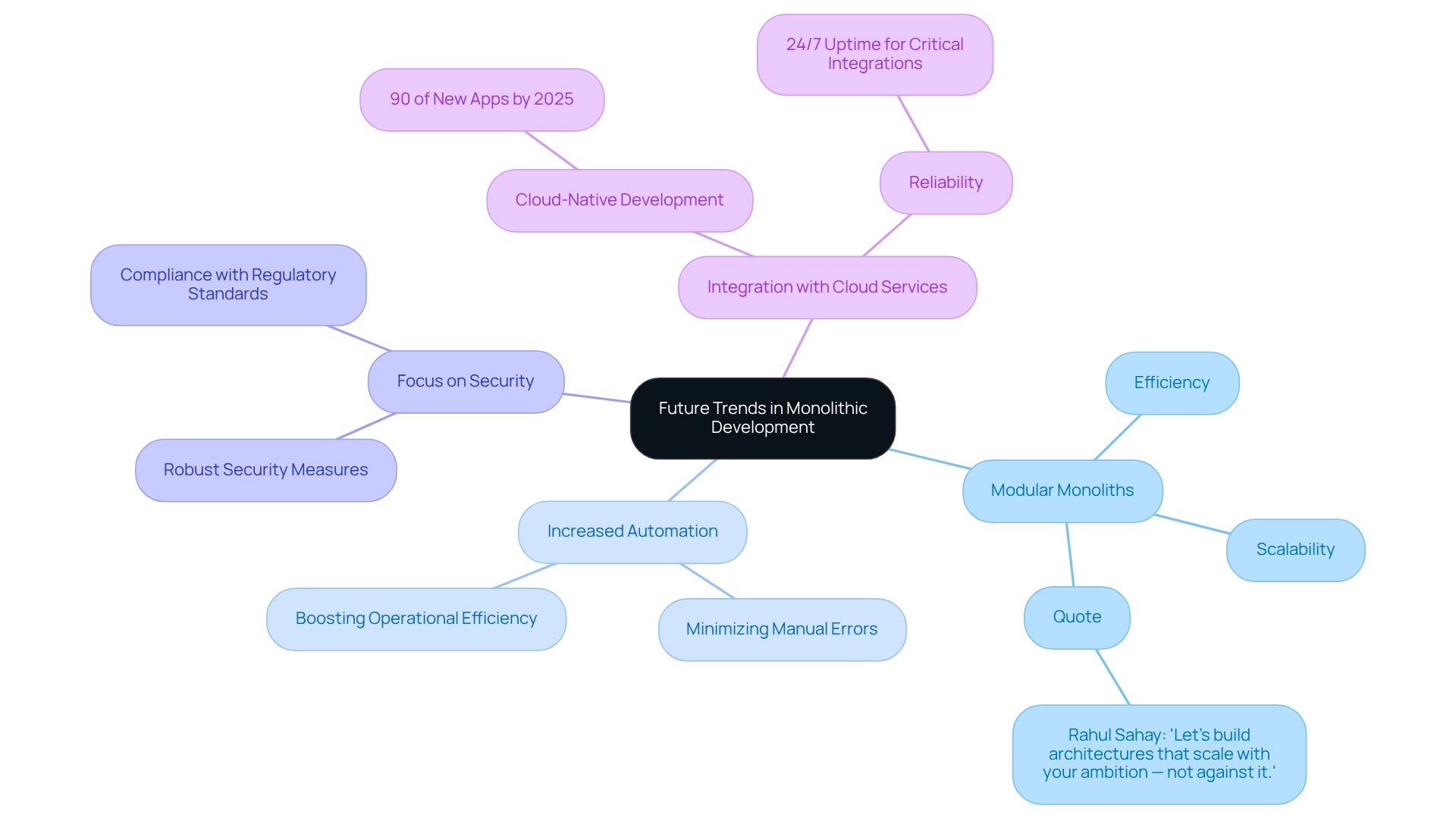Overview
Monolithic development best practices are essential for ensuring compliance and efficiency through a structured approach to software architecture. While monolithic systems provide simplicity and cost-effectiveness, particularly for startups, organizations must confront challenges such as scalability and tight coupling.
How can these challenges be effectively managed? By implementing strategies like:
- Code optimization
- Conducting regular audits
- Integrating legacy systems
Organizations can maintain operational integrity and adaptability in a rapidly evolving technological landscape. As a result, embracing these best practices not only enhances efficiency but also positions organizations for sustainable growth.
Introduction
In the realm of software development, monolithic architecture serves as a foundational design paradigm that integrates all components of an application into a single, cohesive unit. This structure, while offering simplicity and cost-effectiveness, presents significant challenges as projects scale and evolve.
Understanding the nuances of monolithic systems is essential for organizations, particularly in sectors like banking and healthcare, where reliability and compliance are paramount.
As trends shift toward microservices, it becomes crucial to explore the advantages and pitfalls of monolithic development. Are businesses equipped with the knowledge to navigate this complex landscape effectively?
Through a deep dive into best practices, integration strategies, and future trends, this article aims to illuminate the path for organizations seeking to optimize their monolithic applications while maintaining operational integrity.
Understanding Monolithic Architecture: A Foundation for Best Practices
Monolithic development represents a software design paradigm where all components of a system are integrated into a single, cohesive unit. This structure typically encompasses a client-side user interface, server-side program logic, and a database, all closely interlinked to function as one. Understanding this architecture is crucial, as it significantly impacts the creation, implementation, and maintenance of software.
Initially, monolithic development architectures are often simpler to create and implement, making them an attractive option for startups and smaller projects. They facilitate rapid iterations and feedback, which are essential during the early phases of software development. Experts advocate for a monolithic development strategy, particularly for projects poised to evolve into more complex systems.
This approach lays a solid foundation, allowing for quick adjustments before potentially transitioning to microservices as the project expands. A case study titled ‘When to Use Monolithic Development’ substantiates this strategy, illustrating its effectiveness for small projects and the potential for scaling to microservices.
However, as applications expand, the limitations of unified architecture become increasingly apparent. Challenges related to scalability and flexibility can impede growth and responsiveness to shifting market demands. Recent trends indicate a movement towards microservice architectures for larger enterprises, propelled by their advantages in self-sufficiency, technical diversity, and scalability.
As Matt Klein, Chief Engineer at Lyft, observes, “Another significant change that occurs with the development of microservices is the presence of the network as an unstable element that cannot be avoided.” This evolution signifies a broader acknowledgment of the necessity for adaptable systems that can accommodate minor changes without incurring significant disruptions.
Despite these challenges, the advantages of monolithic development are substantial. It streamlines the development process, reduces deployment complexity, and can result in lower initial costs. Moreover, the hybrid integration platform ensures 24/7 uptime for essential integrations, underscoring the importance of reliability in application architecture, especially in sectors such as banking, healthcare, and government.
This platform enhances the value of traditional infrastructures, simplifying complex integrations and significantly reducing expenses. It also offers real-time monitoring and alerts regarding system performance, which are vital for maintaining operational efficiency. Nevertheless, organizations must navigate potential drawbacks, such as the challenges of maintaining large codebases and the risk of system-wide failures due to tightly coupled components.
The key takeaway is that Avato provides a reliable, future-proof technology stack that empowers businesses to adapt to evolving demands.
In conclusion, while unified architecture can serve as an effective starting point for software development, grasping its benefits and challenges is essential for ensuring compliance and efficiency in the long term. As the software development landscape continues to evolve, staying informed about the latest trends and expert insights will be crucial for IT managers across the banking sector and beyond.
Advantages of Monolithic Development: Why Choose This Approach?
Monolithic development presents a range of compelling advantages, particularly for startups and organizations within the banking sector. These benefits include:
-
Simplicity: A monolithic architecture features a single codebase, streamlining both development and deployment processes. This simplicity allows teams to manage and sustain software more efficiently, minimizing the overhead associated with coordinating various services. Furthermore, the company’s hybrid integration platform enhances this process by providing a connected foundation that accelerates the integration of isolated networks and fragmented data.
-
Performance: Monolithic applications can be finely tuned for optimal performance, as all components reside within a unified framework. This configuration reduces latency and improves response times, making it particularly advantageous for high-demand environments, such as banking. Successful implementations, such as Coast Capital’s swift transition of their telephone banking system with minimal downtime (only 63 seconds), exemplify how performance can be maximized in these settings.
-
Cost-Effectiveness: The initial development costs associated with monolithic development are often lower due to reduced complexity. For startups and small businesses, this can translate into significant savings, enabling them to allocate resources more effectively during their early stages. The company’s role in providing affordable hybrid integration solutions has been crucial for financial institutions, allowing them to modernize without incurring high costs. As industry leaders have noted, Avato’s solutions have led to improved operational efficiency and customer satisfaction.
-
Easier Testing and Debugging: The integrated nature of unified applications simplifies testing and debugging processes. In contrast to microservices architectures, where interactions among services can complicate troubleshooting, unified structures enable a more straightforward approach to identifying and resolving issues. The company’s expertise ensures that these systems are designed for secure transactions, providing a robust foundation for digital transformation efforts.
These benefits make monolithic development especially appealing for organizations aiming to quickly launch products while keeping initial investments reasonable. Moreover, successful deployments in the banking industry illustrate the feasibility of integrated systems in achieving regulatory compliance and operational efficiency. As emphasized by industry leaders like Gustavo Estrada, the platform’s capacity to streamline intricate projects and achieve outcomes within specified timelines and budget limits is a crucial factor in the continued preference for unified development among startups and established businesses alike.
Additionally, Avato guarantees 24/7 availability for essential integrations, underscoring the dependability of unified systems in high-demand settings. This reliability is vital, especially when considering the challenges faced by large businesses transitioning to microservices, where complex codebases and scalability issues can arise.

Challenges in Monolithic Development: Navigating Common Pitfalls
Monolithic development presents certain advantages; however, it is fraught with challenges that organizations must navigate to ensure compliance and efficiency.
-
Scalability Issues: As applications grow, expanding a unified system becomes increasingly complex. Unlike microservices, where individual elements can be scaled independently, a unified architecture necessitates simultaneous scaling of all components. This can lead to inefficiencies and significantly higher operational costs, particularly in high-demand scenarios. Avato’s hybrid integration platform addresses these scalability challenges by enabling seamless integration of isolated assets, allowing businesses to adapt more fluidly to changing demands.
-
Tight Coupling: The inherent interdependence of components in a monolithic application complicates the implementation of changes or updates. A modification in one area can inadvertently impact the entire system, resulting in extended development cycles and an increased risk of introducing bugs. Avato simplifies this process, offering a dedicated platform that diminishes the intricacy linked to tight coupling.
-
Deployment Complexity: Although initial deployment may appear straightforward, the process becomes convoluted as the application matures. Updates necessitate meticulous planning and execution to prevent downtime, which can be particularly challenging in regulated environments. Avato ensures 24/7 uptime for critical integrations, allowing organizations to deploy updates with confidence and minimal disruption.
-
Limited Flexibility: The rigidity of monolithic systems can hinder the adoption of new technologies or methodologies. Changes in one part of the application often require extensive modifications throughout, making it difficult to innovate or pivot in response to evolving business needs. Avato empowers businesses to overcome these limitations by providing a flexible integration platform that supports the adoption of new technologies without the need for extensive rework.
Understanding these challenges is essential for organizations striving to enhance their monolithic development processes. For instance, a global e-commerce platform that transitioned to a microservices architecture was able to independently scale components such as user authentication and payment processing, thus enhancing efficiency and user experience. This shift illustrates how addressing scalability issues can lead to significant operational improvements.
As noted by Uber, “The separation of services also encourages a more agile development process, allowing teams to develop, test, and deploy individual components without affecting others.”
As we progress through 2025, the software development landscape continues to evolve, with many experts highlighting the significance of identifying and tackling the drawbacks of large-scale systems. By doing so, organizations can better position themselves to adapt to changing demands and maintain a competitive edge. Avato’s reliable technology stack, born from a dedication to simplifying integration challenges, plays a vital role in helping businesses navigate these challenges effectively.

Ensuring Compliance in Monolithic Development: Key Considerations
Ensuring compliance in the context of monolithic development necessitates a multifaceted approach that addresses several critical considerations.
- Regulatory Awareness: Organizations must remain vigilant regarding evolving regulations, such as GDPR and HIPAA, which are vital for safeguarding personal data. Staying informed about these standards is essential for ensuring that applications not only meet current requirements but are also adaptable to future changes.
This adaptability is particularly supported by a reliable, future-ready technology framework, which assists businesses in aligning their systems with regulatory requirements while mitigating risks through a staged implementation approach that allows for gradual modifications based on feedback.
- Data Security: The implementation of robust security measures is paramount. This encompasses employing encryption techniques and stringent access controls to protect sensitive data.
Considering that 35% of business and tech executives perceive third-party breaches as a major cyber threat, emphasizing data security is crucial for upholding compliance and trust, particularly within the realm of hybrid integration solutions.
- Regular Audits: Conducting systematic audits and assessments of monolithic development applications is essential for identifying compliance gaps. Proactive evaluations can help organizations address potential issues before they escalate, ensuring that compliance is not merely a checkbox but an integral part of the development process.
The company’s commitment to thorough documentation and audit readiness supports this ongoing compliance effort, aligning with the phased implementation approach that emphasizes continuous improvement.
- Documentation: Comprehensive documentation of development processes, data handling practices, and compliance measures is crucial. This not only aids in demonstrating adherence to regulations during audits but also serves as a valuable resource for training and future development efforts.
The company underscores the significance of clear documentation as part of its commitment to simplifying varied systems and enhancing business value, ensuring that all stages of implementation are thoroughly documented and transparent.
- Expert Insights: Compliance officers highlight the importance of staying ahead of regulatory changes. As noted by industry experts, keeping abreast of upcoming legislative shifts is a top strategic priority for many organizations, particularly in the next 12 to 18 months.
The team’s integration specialists are dedicated to delivering insights that assist businesses in managing these changes efficiently, directly aiding the gradual implementation and compliance procedures by providing customized strategies that conform to regulatory standards.
- Case Studies: Insights from case studies, such as those focusing on risk management in large-scale construction, underscore the necessity for effective risk assessment methods. These methodologies can be adapted to software development, illustrating the importance of structured approaches to compliance and risk management.
The case studies demonstrate how Avato’s hybrid integration platform can enhance compliance efforts and risk management strategies, showcasing the practical application of these principles in real-world scenarios.
By prioritizing these factors and utilizing Avato’s phased implementation strategy, organizations can significantly reduce the risks associated with non-compliance, thereby enhancing their operational integrity and establishing a strong framework for future development.
Best Practices for Enhancing Efficiency in Monolithic Applications
To enhance efficiency in monolithic applications, organizations must implement the following best practices:
-
Code Optimization: Conduct regular reviews and refactor code to eliminate redundancies and enhance performance. This practice not only results in quicker execution times but also decreases resource usage, ultimately enhancing the system’s responsiveness.
-
Database Management: Focus on optimizing database queries and indexing strategies. Effective database management can greatly improve data retrieval speeds, which is essential for sustaining high software performance, particularly in data-heavy environments.
-
Caching Strategies: Implement effective caching mechanisms to minimize load times. By decreasing the frequency of data retrieval from the database, caching enhances user experience and system responsiveness, which is essential in sectors like banking where speed is crucial.
-
Automated Testing: Integrate automated testing into the development lifecycle. This method permits early detection of problems, ensuring that updates do not introduce new errors and preserving the integrity of the system.
-
Performance Monitoring: Utilize real-time monitoring tools to track software performance continuously. This enables teams to identify bottlenecks and address them proactively, ensuring optimal operation.
-
Adopting Agile Methodologies: Embrace agile practices, as 74% of developers report that such methodologies enhance their ability to manage project uncertainties. Agile frameworks support iterative development and ongoing enhancement, which are crucial for optimizing large-scale systems.
In the realm of software development, it is essential to acknowledge that misleading metrics can result in misguided decisions. As Lin Jia notes, “Why do some A/B tests show success but fail in practice? Learn how KPI traps, false positives, and misaligned metrics can lead to misleading experiment results.”
This underscores the importance of accurate performance measurement in ensuring that optimization efforts yield tangible benefits.
By adopting these practices, organizations can significantly enhance the efficiency of their large-scale applications through monolithic development, leading to improved performance and greater user satisfaction. For instance, the E-code program synthesis model demonstrated a 54.98% improvement in code efficiency, showcasing the potential benefits of focused optimization efforts. Such results emphasize the significance of strategic improvements in attaining operational excellence in unified architectures.

Integrating Legacy Systems: Strategies for Monolithic Environments
Incorporating legacy infrastructures within monolithic development presents unique challenges, yet it is a crucial step toward modernization. Organizations must navigate this complexity effectively by adopting strategic approaches that not only address these challenges but also optimize their technological environment.
API Development: Creating strong APIs is essential for enabling seamless communication between legacy frameworks and new applications. This approach not only enhances data exchange but also integrates functionalities, allowing businesses to leverage existing frameworks while embracing new technologies. Avato’s hybrid integration platform excels in this area, providing secure and efficient data connectivity that empowers organizations to future-proof their operations.
Incremental Upgrades: Rather than undertaking a complete overhaul of outdated frameworks, organizations should consider gradual enhancements. This strategy facilitates continuous improvements, minimizing disruption to ongoing operations and enabling teams to adapt smoothly to changes. As industry insights suggest, businesses should avoid rushing legacy IT transformations and instead focus on upgrading elements that yield significant benefits.
Middleware Solutions: Implementing middleware platforms can significantly bridge the gap between legacy technologies and modern applications. These solutions enhance data flow and interoperability, ensuring that various platforms collaborate effectively, which is essential for maintaining operational continuity. Avato’s expertise in hybrid integration ensures that these middleware solutions are tailored to meet specific business needs.
Data Migration: Careful planning and execution of data migration strategies are critical. Organizations must ensure that legacy data is accurately transferred to new platforms without loss or corruption, safeguarding the integrity of valuable information. Utilizing XSLT for efficient XML data transformation can streamline this process, reducing programming errors and associated costs.
By employing these strategies, organizations can successfully update their technology environment while optimizing their investments in monolithic development alongside legacy infrastructures. Continuous monitoring and analysis post-integration are essential for enhancing performance and addressing any vulnerabilities that may arise, ensuring a resilient and future-proof infrastructure. As customer Gustavo Estrada stated, “Avato has simplified complex projects and delivered results within desired time frames and budget constraints,” underscoring the effectiveness of these approaches.
Moreover, with the average cyber attack costing businesses $9.48 million in 2023, secure integration is paramount. The benefits of modernizing legacy systems can provide organizations with a competitive advantage, improved employee experience, and opportunities for growth, as highlighted in a relevant case study.
Monitoring and Performance Management: Ensuring Ongoing Compliance and Efficiency
Effective monitoring and performance management are crucial for ensuring compliance and efficiency in monolithic development systems. By implementing best practices in this area, organizations can significantly enhance software performance and user satisfaction. Key practices include:
-
Centralized Logging: Establish centralized logging solutions to consolidate logs from various components. This method streamlines the monitoring of software performance and aids in the identification of problems, enabling faster resolutions.
-
Performance Metrics: Clearly define and track essential performance metrics, such as response times and error rates. Monitoring these metrics is essential for evaluating software health and ensuring a positive user experience.
-
Automated Alerts: Implement automated alerts to notify teams of performance anomalies or compliance breaches. This proactive measure enables rapid responses to potential issues, minimizing downtime and maintaining operational integrity. Continuous monitoring and robust analytics capabilities are essential in this regard, as they provide insights that can optimize operations and enhance customer experiences.
-
Regular Reviews: Conduct regular performance evaluations and audits to ensure that the system adheres to compliance standards and operates efficiently. These evaluations assist in recognizing areas for enhancement and ensure that the system develops with shifting requirements. By leveraging analytics, organizations can not only meet regulatory compliance but also identify new opportunities for innovation.
-
Implementation Guidelines: To effectively execute continuous monitoring and optimization, organizations should create a framework that encompasses defining key performance indicators (KPIs), employing analytics tools for real-time data analysis, and routinely updating monitoring protocols to adjust to new challenges.
By prioritizing these monitoring and performance management strategies, organizations can maintain the integrity and efficiency of their large-scale systems, ultimately supporting their broader business objectives. As noted by Gustavo Estrada, a customer, ‘Avato has the ability to simplify complex projects and deliver results within desired time frames and budget constraints.’ This capability is essential for maintaining operational functions and compliance in large-scale applications, especially in a landscape where speed, security, and simplicity are paramount.

Future Trends in Monolithic Development: Preparing for Change
As technology continues to evolve, several key trends are shaping the future of monolithic development:
-
Modular Monoliths: The rise of modular monoliths is revolutionizing conventional architecture. This approach combines the simplicity of unified systems with the flexibility of modular design, enabling organizations to achieve a balance between efficiency and scalability. By adopting modular monoliths, businesses can enhance their ability to innovate while maintaining a cohesive architecture. As Tech Architect Rahul Sahay aptly puts it, “Let’s build architectures that scale with your ambition — not against it.”
-
Increased Automation: Automation is poised to play a pivotal role in deployment and monitoring processes. As organizations strive to minimize manual errors and boost operational efficiency, the integration of automated tools will become increasingly prevalent. This shift not only streamlines workflows but also accelerates the delivery of software updates and features.
-
Focus on Security: With the increase in data breaches and strict compliance demands, security will become paramount in the development of unified systems. Organizations will prioritize robust security measures, ensuring that their software is resilient against threats while adhering to regulatory standards.
-
Integration with Cloud Services: The connection of large-scale applications with cloud services is anticipated to enhance scalability and flexibility. This synergy allows organizations to leverage the strengths of both architectures, facilitating rapid deployment and resource optimization. As cloud-native development becomes the norm, with projections indicating that 90% of new apps will adopt this architecture by 2025, the ability to seamlessly connect monolithic systems with cloud platforms will be crucial for maintaining a competitive edge. Furthermore, the hybrid integration platform guarantees 24/7 uptime for critical integrations, underscoring the significance of reliability in this evolving landscape. The company is dedicated to architecting the technology foundation required to power rich, connected customer experiences, making it a key player in enhancing business value through seamless and secure data connectivity. As one of our clients noted, “Avato’s hybrid integration platform has transformed our approach to system integration, allowing us to focus on innovation rather than infrastructure.”
By staying informed about these trends, organizations can proactively adapt their development strategies, ensuring compliance and efficiency in a rapidly changing technological landscape. The recent surge in modular construction in healthcare facilities, particularly highlighted during the COVID-19 pandemic, illustrates the practical application of monolithic development in relevant industry contexts, further emphasizing the need for adaptable and resilient architectures.

Conclusion
Monolithic architecture continues to be a pivotal design paradigm in software development, offering a compelling mix of simplicity, cost-effectiveness, and operational integrity. While this approach facilitates rapid development and deployment, organizations must confront the inherent challenges that arise as applications increase in complexity. It is crucial to grasp the nuances of monolithic systems, particularly in sectors such as banking and healthcare, where reliability and compliance are non-negotiable.
The key advantages of monolithic development—streamlined processes, optimal performance, and cost savings—make it an attractive option for startups and smaller organizations. However, as businesses scale, limitations in scalability, flexibility, and deployment complexity become increasingly evident. Organizations must navigate these challenges by implementing best practices, optimizing code, and leveraging effective integration strategies to enhance efficiency and ensure compliance.
Looking ahead, the evolution of monolithic architecture is set to embrace trends such as modular monoliths and increased automation. These developments promise to balance the benefits of simplicity with the necessity for flexibility and adaptability. By remaining informed about these trends and adopting a proactive approach, organizations can optimize their monolithic applications, ensuring competitiveness in a rapidly changing technological landscape.
Ultimately, a comprehensive understanding of both the advantages and challenges of monolithic architecture will empower organizations to make informed decisions. This knowledge fosters innovation while maintaining the reliability and compliance that are critical to their success.

